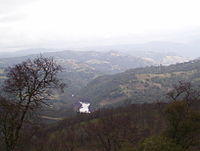Calaveras County
| Calaveras County, California | |||
|---|---|---|---|
| County | |||
| County of Calaveras | |||

Calaveras County view
|
|||
|
|||
 Location in the state of California |
|||
 California's location in the United States |
|||
| Country | |||
| State |
|
||
| Regions | Sierra Nevada, Gold Country | ||
| Incorporated | February 18, 1850 | ||
| County seat | San Andreas | ||
| Largest community | Rancho Calaveras | ||
| Area | |||
| • Total | 1,037 sq mi (2,690 km2) | ||
| • Land | 1,020 sq mi (2,600 km2) | ||
| • Water | 17 sq mi (40 km2) | ||
| Population (April 1, 2010) | |||
| • Total | 45,578 | ||
| • Estimate (2015) | 44,828 | ||
| • Density | 44/sq mi (17/km2) | ||
| Time zone | Pacific Time Zone (UTC-8) | ||
| • Summer (DST) | Pacific Daylight Time (UTC-7) | ||
| Area code | 209 | ||
| FIPS code | 06-009 | ||
| GNIS feature ID | 1675885 | ||
| Website | www |
||
Calaveras County, officially the County of Calaveras, is a county in the northern portion of the U.S. state, California. As of the 2010 census, the population was 45,578. The county seat is San Andreas, and Angels Camp is the only incorporated city. Calaveras is the Spanish word for skulls; the county was reportedly named for the remains of Native Americans discovered by the Spanish explorer Captain Gabriel Moraga.
Calaveras County is in both the Gold Country and High Sierra regions of California.
Calaveras Big Trees State Park, a preserve of Giant Sequoia trees, is in the county several miles east of the town of Arnold on State Highway 4. Credit for the discovery of giant sequoias here is given to Augustus T. Dowd, a trapper who made the discovery in 1852 while tracking a bear. When the bark from the "Discovery Tree" was removed and taken on a tour around the world, the trees became a worldwide sensation and one of the county's first tourist attractions. The uncommon gold telluride mineral calaverite was discovered in the county in 1861 and is named for it.
Mark Twain set his story, "The Celebrated Jumping Frog of Calaveras County", in the county. The county hosts an annual fair and Jumping Frog Jubilee, featuring a frog-jumping contest, to celebrate the association with Twain's story. Each year's winner is commemorated with a brass plaque mounted in the sidewalk of downtown Historic Angels Camp and this feature is known as the Frog Hop of Fame. The California red-legged frog, feared extinct in the county by 1969, was rediscovered in 2003.
...
Wikipedia


